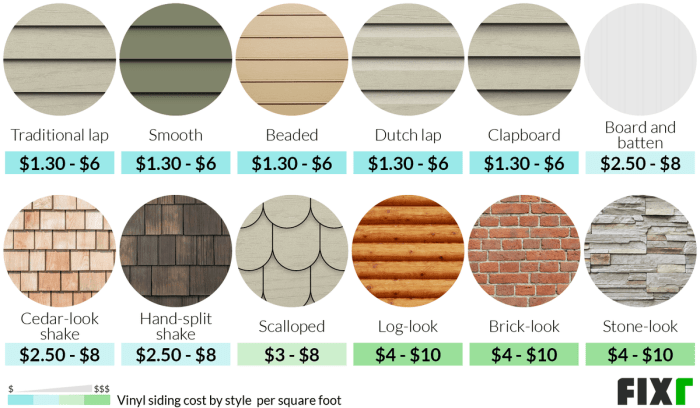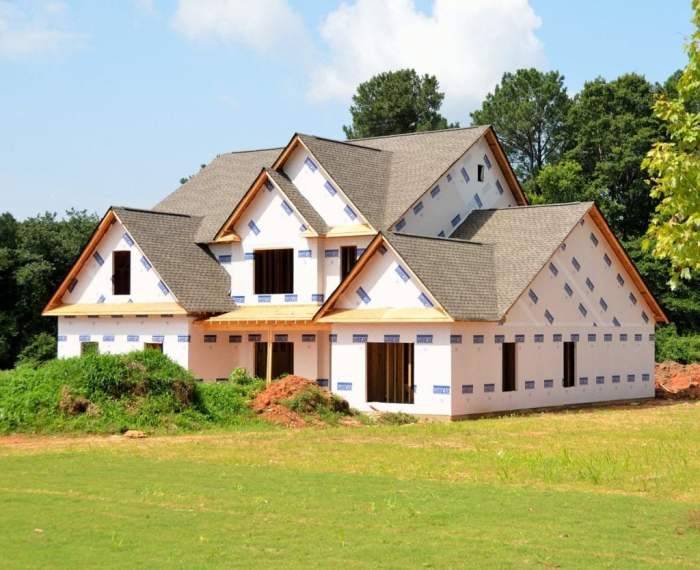Delving into the realm of vinyl siding costs and installation, this article sets the stage for a comprehensive exploration that will shed light on key factors influencing pricing and materials.
Moving forward, it will uncover the different types of vinyl siding, installation processes, and maintenance practices to provide a well-rounded view of this topic.
Cost of Vinyl Siding and Installation
When considering the cost of vinyl siding and installation, several factors come into play that can influence the overall price. It is essential to understand the breakdown of costs to make an informed decision when undertaking a siding project.
Factors Influencing Cost
- The quality and type of vinyl siding chosen can significantly impact the cost. Higher-quality materials may be more expensive but offer better durability and aesthetics.
- The size of the house and the layout of the exterior walls can affect the amount of material needed, thus influencing the overall cost.
- The complexity of the installation process, including any additional features like insulation or trim, can add to the labor costs.
- The location of the house and local labor rates can also play a role in determining the final cost of vinyl siding installation.
Material vs. Labor Costs
- On average, the cost of materials accounts for about 30% to 50% of the total cost of vinyl siding installation.
- Labor costs typically make up the remaining 50% to 70% of the overall cost, depending on the complexity of the project and the rates charged by the installation professionals.
Impact of House Size and Layout
- Larger houses with more exterior walls will require more materials and labor, leading to higher overall costs.
- The layout of the house, including the presence of dormers, gables, or other architectural features, can add complexity to the installation process and increase costs.
Additional Features and Upgrades
- Adding insulation under the vinyl siding can improve energy efficiency but will come with an additional cost.
- Trim details, such as corner posts, window surrounds, and soffits, can enhance the aesthetic appeal of the siding but will also add to the total cost.
Vinyl Siding Options
When it comes to vinyl siding, there are various options available in the market to suit different preferences and budgets. The type of vinyl siding you choose can significantly impact the overall cost of the project.
Types of Vinyl Siding
- Traditional Vinyl Siding: This is the most common type of vinyl siding and is known for its durability and affordability.
- Insulated Vinyl Siding: This type of siding comes with built-in insulation, which can help improve energy efficiency but comes at a higher cost.
- Architectural Vinyl Siding: This premium option offers a more detailed and textured appearance, mimicking the look of real wood or stone.
Cost Comparison
- Traditional Vinyl Siding: Costs range from $2 to $7 per square foot for materials, with installation costs averaging around $4 to $7 per square foot.
- Insulated Vinyl Siding: Prices start at $4 per square foot for materials, with installation costs ranging from $6 to $10 per square foot.
- Architectural Vinyl Siding: This premium option can cost between $4 to $12 per square foot for materials, with installation costs ranging from $8 to $12 per square foot.
Impact of Color, Texture, and Design
- Color: Custom colors or special finishes may increase the cost of vinyl siding.
- Texture: Textured vinyl siding can add to the aesthetic appeal but may come at a higher price.
- Design: Intricate designs or patterns on the siding can also affect the overall cost of the project.
Premium vs. Standard Vinyl Siding
- Choosing premium vinyl siding with additional features like insulation, enhanced durability, or unique designs will naturally increase the overall cost of the project.
- Standard vinyl siding, while more budget-friendly, may lack some of the advanced features and design options found in premium options.
Installation Process

Installing vinyl siding involves several key steps to ensure a successful and long-lasting result. It is essential to understand the process, tools needed, and whether to hire professionals or attempt a DIY installation.
Steps Involved in Installing Vinyl Siding
- Prepare the surface by removing old siding and ensuring a smooth, clean foundation.
- Measure and cut the siding panels to fit the dimensions of the walls.
- Install the starter strip at the bottom of the wall to secure the first row of siding.
- Interlock the siding panels by sliding them into place and securing them with nails.
- Finish the installation with trim pieces around windows, doors, and corners for a polished look.
Tools and Equipment Required for Installation
- Vinyl siding panels
- Starter strip
- Nails and screws
- Siding cutter or saw
- Level and measuring tape
- Hammer or nail gun
- Caulk and sealant
Importance of Hiring Professionals vs. DIY
- Professionals have experience and expertise to ensure a proper installation, minimizing the risk of errors.
- DYI installation may seem cost-effective initially, but mistakes can lead to additional expenses for repairs or replacements.
- Professionals can also offer warranties on their work, providing peace of mind for homeowners.
Tips for Cost-Effective and Efficient Installation
- Plan ahead and measure accurately to avoid waste or the need for extra materials.
- Consider purchasing siding in bulk or during sales to save on costs.
- Follow manufacturer instructions carefully to ensure proper installation and maximize the lifespan of the siding.
- If hiring professionals, compare quotes from multiple contractors to find the best value for the quality of work.
Maintenance and Longevity

Maintaining vinyl siding is essential for its longevity and overall cost-effectiveness. By following proper maintenance practices, homeowners can extend the lifespan of their vinyl siding and minimize long-term costs.
Impact of Maintenance on Cost
Proper maintenance, such as regular cleaning and inspections, can help prevent issues like mold, mildew, and discoloration, saving you money on repairs or replacements in the future. Simple tasks like washing the siding with a mild detergent and water can go a long way in preserving its appearance and structural integrity.
Longevity of Vinyl Siding
Vinyl siding is known for its durability and long lifespan. With proper care, vinyl siding can last for 20-40 years, making it a cost-effective option in the long run. Regular maintenance, including inspections for damage or warping, can help ensure that your vinyl siding remains in good condition for years to come.
Tips for Extending Lifespan
- Regularly clean the siding to remove dirt, debris, and mold.
- Inspect for any signs of damage, such as cracks or loose panels, and repair them promptly.
- Avoid using harsh chemicals or abrasive materials that can damage the siding.
- Trim trees and bushes near the siding to prevent scratches or damage from branches.
- Consider applying a protective coating to enhance the durability of the vinyl siding.
Comparison with Other Siding Materials
Vinyl siding is relatively low maintenance compared to other siding materials like wood or aluminum. While initial costs may vary, the long-term maintenance costs of vinyl siding are generally lower, making it a cost-effective choice for homeowners looking for durable and low-maintenance siding options.
Conclusion
In conclusion, the cost of vinyl siding and installation is a multifaceted subject that requires careful consideration. By understanding the nuances of pricing, materials, and maintenance, homeowners can make informed decisions for their siding needs.
Quick FAQs
What factors influence the cost of vinyl siding and installation?
Factors such as material quality, house size, additional features, and labor costs can all impact the overall cost of vinyl siding and installation.
How does maintenance affect the cost of vinyl siding?
Regular maintenance can help prolong the lifespan of vinyl siding, reducing long-term costs associated with repairs or replacements.
Is DIY installation cost-effective compared to hiring professionals?
While DIY installation may seem cheaper upfront, hiring professionals can ensure a proper and efficient installation that may save costs in the long run.
